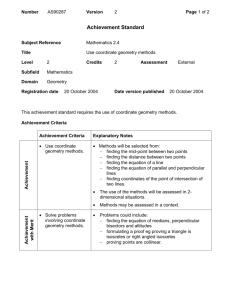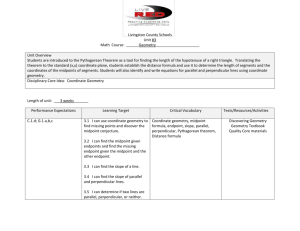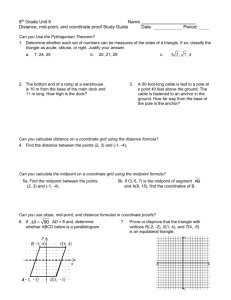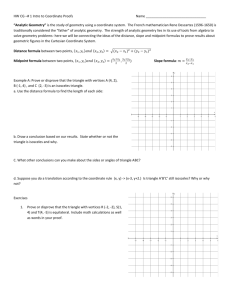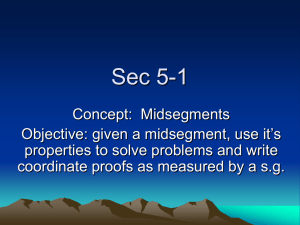VMHS Math Circle
advertisement
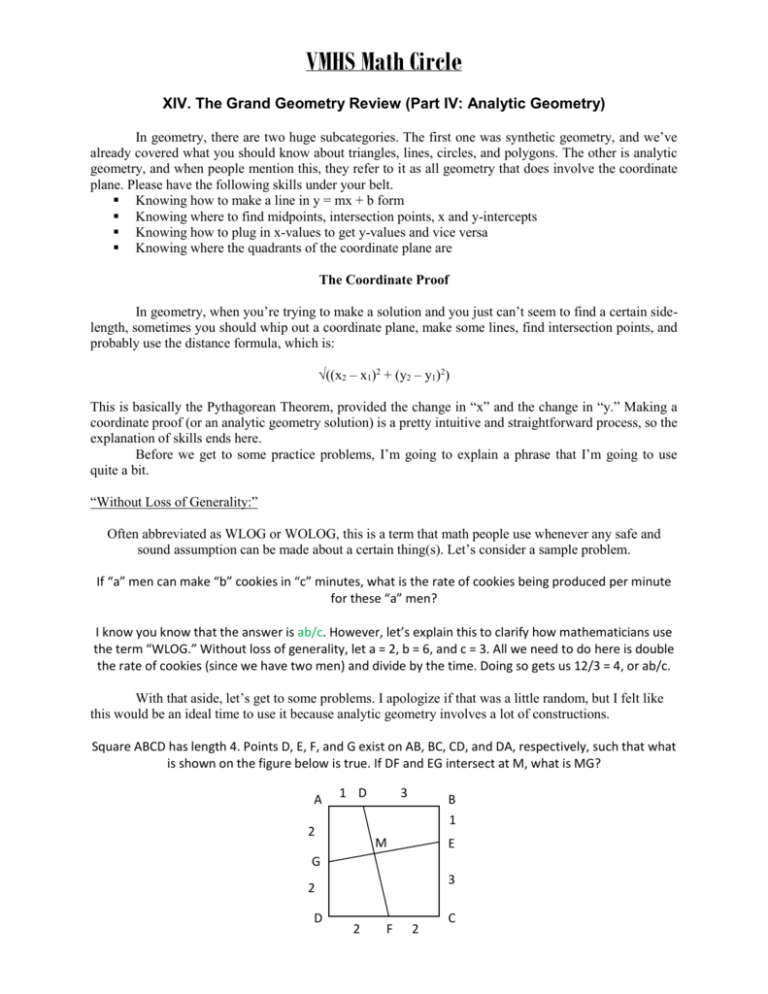
VMHS Math Circle XIV. The Grand Geometry Review (Part IV: Analytic Geometry) In geometry, there are two huge subcategories. The first one was synthetic geometry, and we’ve already covered what you should know about triangles, lines, circles, and polygons. The other is analytic geometry, and when people mention this, they refer to it as all geometry that does involve the coordinate plane. Please have the following skills under your belt. Knowing how to make a line in y = mx + b form Knowing where to find midpoints, intersection points, x and y-intercepts Knowing how to plug in x-values to get y-values and vice versa Knowing where the quadrants of the coordinate plane are The Coordinate Proof In geometry, when you’re trying to make a solution and you just can’t seem to find a certain sidelength, sometimes you should whip out a coordinate plane, make some lines, find intersection points, and probably use the distance formula, which is: √((x2 – x1)2 + (y2 – y1)2) This is basically the Pythagorean Theorem, provided the change in “x” and the change in “y.” Making a coordinate proof (or an analytic geometry solution) is a pretty intuitive and straightforward process, so the explanation of skills ends here. Before we get to some practice problems, I’m going to explain a phrase that I’m going to use quite a bit. “Without Loss of Generality:” Often abbreviated as WLOG or WOLOG, this is a term that math people use whenever any safe and sound assumption can be made about a certain thing(s). Let’s consider a sample problem. If “a” men can make “b” cookies in “c” minutes, what is the rate of cookies being produced per minute for these “a” men? I know you know that the answer is ab/c. However, let’s explain this to clarify how mathematicians use the term “WLOG.” Without loss of generality, let a = 2, b = 6, and c = 3. All we need to do here is double the rate of cookies (since we have two men) and divide by the time. Doing so gets us 12/3 = 4, or ab/c. With that aside, let’s get to some problems. I apologize if that was a little random, but I felt like this would be an ideal time to use it because analytic geometry involves a lot of constructions. Square ABCD has length 4. Points D, E, F, and G exist on AB, BC, CD, and DA, respectively, such that what is shown on the figure below is true. If DF and EG intersect at M, what is MG? A 1 D 2 3 B 1 M E G 3 2 D 2 F 2 C All right, so let’s just pick a point. Let’s say that “G,” without loss of generality, is positioned at the origin (0, 0). It’s crucial to find the point of intersection of GE and DF, so we should first find the equations of line GE and line DF. For GE, we have to consider the change in y and the change in x from G to E to find the slope. Surely enough, this is 1/4, and since GE passes through the origin, its line is simply y = (1/4)(x). For DF, we still have to consider that point G is at the origin, so we basically construct the equation of line DF in reference to point G. In reference to point G, point D is at (1, 2), while point F is at (2, -2). The slope of DF is -4 when we consider the change in y and the change in x from D to F. Using point-slope, the equation for DF is y – 2 = -4(x – 1) y = -4x + 6. Now, the point of intersection of the two lines M is (24/17, 6/17). To find MG, all we need to do is find the distance between M and the origin! Doing so, we get: √(576/289 + 36/289) = (6√7)/17. Three squares are stacked on top of each other. The centers of all three of these squares are collinear, and their side lengths are in the ratio 1:2:3 going down. A triangle is made from the midpoint of the top edge and the two bottom corners of the bottom square, as shown. What is the ratio of shaded region B to shaded region A? A B For the sake of our coordinate proof, let’s flip this thing sideways. M O N Let’s call the tip of this triangle “O.” Also, let’s call our other vertices “M” and “N.” WLOG, let O be at the origin, and let these squares have sides 2, 4, and 6 going from left to right. Thus, M is at (12, 3). This renders OM to have the equation y = (1/4)(x). Similarly, ON has the equation y = (-1/4)(x). To find the area of the triangular region A, we find the height and base. The height is 1, and the base is the distance between the intersections of the right vertical edge of our first square with OM and ON. These points are positioned at (1, 1/4) and (1, -1/4), so the distance between these points is 1/2. Hence, the area of region A is (1/2)(1)(1/2) = 1/4. Region B, on the other hand, is an isosceles trapezoid of height 3. One of its bases has length 3, and the other’s length is determined by the intersections of the left vertical edge of our third square with OM and ON. Again, these points are positioned at (3, 3/4) and (3, -3/4), so the distance between these is 3/2. Using the formula for the area of a trapezoid, the area is region B is (3/2)(3/2 + 3) = 27/4. To find the ratio of the areas of region B to region A, just divide the areas. We thus get (27/4)/(1/4) = 27. Other times, the AMC will explicitly refer to coordinates and require you to work with what’s given. Here’s a practice problem to clarify this. The vertices of a triangle ABC on the Cartesian plane are A: (0, 0), B: (4, 3), and C: (x, y). Given that x ≥ 0 and y ≥ 0, what is the area of the region bounded by the positive x and y-axes and the locus of all points (x, y) that make triangle ABC isosceles without AC = AB? I apologize if the wording of this problem may be a bit flawed. At least this isn’t the real AMC (the people who make the problems probably discuss their validity for the entire year). When you see the word “locus,” replace it with the word “set.” This makes it clearer what you’re trying to figure out. We’re now looking for the set of points in the first quadrant or the positive x or y axes that make triangle ABC isosceles. It takes quite a bit of imagination to figure out. We start with this (zoom in if you can’t see). To progress in this problem, we have to consider two cases: AB = BC, and AC = BC (note that the problem threw AB = AC out). When AB = BC, we know that BC must have length √(32 + 42) = 5. The set of points satisfying this is a circle of radius 5. One thing to mention is that the point (x, y), in which triangle ABC degenerates into a line is insignificant out of the infinitely many points that don’t make triangle ABC degenerate. Point is: ignore the origin, and ignore (8, 6). The origin isn’t even part of the positive x and y-axes, anyway. We then have: Now for AC = BC. The set of points satisfying this relation is the line y = (-4/3)(x) + 25/6. Why? We know that the altitudes of isosceles triangles are perpendicular bisectors. Hence, if we make a line perpendicular to the midpoint of AB, we get points along this line satisfying AC = BC. Then, after observing that the line determined by points (0, 6) and (8, 0) is the diameter of the circle, we have: Now we know what we want to find. Let’s shade this area green. Our answer is the area of a semicircle with radius 5 plus that of a 6-8-10 right triangle minus that of a right triangle with legs 6 and 25/8. Thus, we get 25π/2 + (1/2)(6)(8) – (1/2)(25/6)(25/8) = 25π/2 + 1679/96. Sometimes, you may have to pull in a coordinate plane spontaneously in the midst of doing a lot of synthetic geometry. It’s time for the usual overkill example. Leanne has an 8 x 11 piece of rectangular paper. She labels this paper ABCD, with A and B as corners on the shorter dimension of the paper, and she decides to make a certain kind of paper airplane. To do this, she considers center line MN, with M being the midpoint of AB and N being the midpoint of CD and folds her paper in the following way: First, she folds corners A and B onto center line MN so that A and B meet at point E and that center line MN contains segment ME. She then flips the paper over and folds tip M along segment XY perpendicular to AD, with X on AD and Y on BC. The image of M that becomes folded is M’. She then chooses points P and Q along crease XY that are 3 inches away from X and Y, respectively. She also chooses points R and S that are 4 inches from X and Y, respectively and lie on XD and YC, respectively. This way, she folds corners X and Y along creases PR and QS. The new images of X and Y are X’ and Y’. If SY’ and YM’ intersect at α, and RX’ and XM’ intersect at β, find the length of segment αβ. Refer to the diagram on the next page for aid. A M M B Y Y X E X E M’ D N D C Y’ α X’ β M’ C N D P Q S C C N N R D Okay, so the main thing we’ll be looking at is our bottom template with α and β. We note that if MN contains ME, the first folds make a 45˚ angle with edge AB. If the fold of M to get M’ basically inverts this angle. Let’s get started with our coordinate proof. It’s clear that what we want to do is find the coordinates of point α. This is the solution (x, y) to both equations of lines SY’ and YM’. We position point S at the origin. Thus, point Y is at (0, 4), point R is at (8, 0), point X is at (8, 4), and point M is at (4, 0). Let’s start with SY’. To get Y’, we need to reflect point Y across the line y = (4/3)(x). To do this, we drop a perpendicular from (4, 0) to y = (4/3)(x) and make the foot of this perpendicular the midpoint of line YY’. Y Y’ S Clearly, the equation of YY’ is y = (-3/4)(x) + 4. This line and y = (4/3)(x) meet at (48/25, 64/25). Now, we plug into the midpoint formula to get the coordinates of Y’. x/2 = 48/25; (4 + y)/2 = 64/25 x = 96/25, y = 28/25 Since the slope of a line passing through the origin is simply y/x, the equation of SY’ is simply y = (7/24)(x). The intersection of this line and the equation of YM’– y = -x + 4 –is (96/31, 28/31). We do the same thing for β. Since we already know the slope of SY’, the slope of X’R has the opposite sign since the folds are symmetric across center line MN. Hence, all we need to do is use point-slope with slope (-7/24) and point (8, 0). The equation of X’R is y – 0 = (-7/24)(x – 8) y = (-7/24)(x) + 7/3. Now, we find the intersection of the line XM’– y = x – 4 –with X’R. This is (152/31, 28/31). Thus, the length of αβ is 152/31 – 96/31 = 56/31. TIPS: Never, ever change your origin for a coordinate proof unless you want to start it over. If you choose a point to be an origin, always make your coordinate proof in reference to that point. It’s good to set up a coordinate proof if you can’t use any geometry skills you have, but you know slopes. That is, if you have enough given information to craft the lines of an equation and find intersection points, go ahead and do it.

